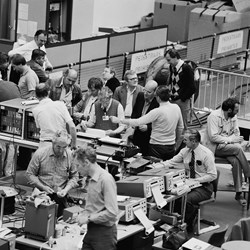ITER NEWSLINE
-
The story of a JET pulse
Culham Centre for Fusion Energy (CCFE)

JET came to life with the first plasma on 25 June 1983. Here is a view of the the JET Diagnostic Hall, which was turned into a temporary control room for the occasion. JET's director Paul Rebut is seen here discussing with Michel Huguet, who was to head the ITER Joint Work Site (JWS) at Naka. Leaning on the railing, is Juergen Dietz, who was head of In-Vessel Division at the Garching ITER JWS in the early years of the ITER Engineering Design Activities.
In 30 years of operations JET has produced over 80,000 pulses. Although an everyday occurrence during experimental campaigns, how a pulse is prepared and processed deserves its own special story.
So what is meant by the term? A pulse is the name given to the time a plasma is held in the JET vessel. To create fusion in a future power station a plasma, or very hot electrically charged gas, has to be sustained inside the tokamak vessel whilst optimising three specific conditions: temperature, density and confinement time. This is called the fusion triple product and two isotopes of hydrogen, deuterium and tritium, are used to make the reaction occur.

A comics rendition of a countdown to plasma at JET: the first shift of the day is just starting and 15 pulses are planned.
Unlike future stations when the plasma will need to run for several hours or continuously, on JET, each pulse typically lasts around 40 seconds. Although this may seem like a short amount of time, the 80,000 or so plasmas already created in the machine since 1983 have provided crucial information for plasma science by focusing on its behaviour and improving its performance. The pulses have all contributed to an extensive knowledge bank of data (with over 100 TeraBytes of data collected to date) and their analysis plays a key part in the long-term goal of fusion electricity on the grid.
Like all good stories —the story of a pulse has a distinct beginning, middle and end, a strong setting and involves many people in this case engineers, scientists and computer experts who all have fascinating parts to play.
Read the whole story on CCFE website.
return to the latest published articles








